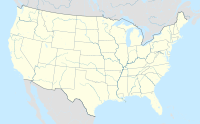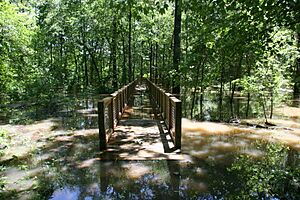White River National Wildlife Refuge facts for kids
Quick facts for kids White River National Wildlife Refuge |
|
|---|---|
| Location | Arkansas, United States |
| Nearest city | De Witt, Arkansas |
| Area | 160,756 acres (650.56 km2) |
| Established | 1935 |
| Governing body | U.S. Fish and Wildlife Service |
| Website | White River NWR |
| Official name: Cache-Lower White Rivers | |
| Designated: | 21 November 1989 |
| Reference #: | 442 |
The White River National Wildlife Refuge, also known as the Dale Bumpers White River National Wildlife Refuge, is a huge natural area in Arkansas, United States. It covers about 160,756 acres, which is like 120,000 football fields! This special place is managed by the United States Fish and Wildlife Service. Their job is to protect the land and the animals living there. The refuge is next to the Cache River National Wildlife Refuge in the north.
In 1974, a part of the refuge called the White River Sugarberry Natural Area became a National Natural Landmark. This means it's a very important natural site. In 2013, there was a plan to make the refuge even bigger, possibly growing to almost 298,000 acres.
Contents
About the White River Refuge

The White River National Wildlife Refuge was created in 1935. It stretches for about 90 miles along the lower part of the White River. The refuge is usually 3 to 10 miles wide. It also includes a small part of the Arkansas Post Canal. This canal is part of a bigger water system on the Arkansas River.
Amazing Animals of the Refuge
This refuge is a very important home for many animals. It has the largest group of mallard ducks that spend the winter here in the entire Mississippi Flyway. You can also see lots of snow and Canada geese.
The refuge is home to four active nests of bald eagles, which are America's national bird. There's also a growing population of black bears. Their numbers have increased from about 25 in the 1940s to over 300 today! Some people even believe that the very rare ivory-billed woodpecker might still live here, even though it's thought to be extinct.
Forests and Waterways
The refuge is part of a large forest area called the Mississippi lowland forests. Inside the refuge, there's a special area called the Sugarberry Natural Area. It has a 973-acre old-growth forest. This means the trees are very old and have been growing for a long time.
The forest has different types of trees, like American sweetgum, Nuttall's oak, willow oak, sugarberry, American elm, green ash, American sycamore, and baldcypress.
The refuge has 356 lakes, both natural and man-made. These lakes cover about 4,000 acres. Most of the refuge, about 154,000 acres, is covered by forests. There are also smaller areas of farmland and grassland. Because of its important wetlands, the refuge is known as a Wetland of International Importance.
Plans to Expand the Refuge
In 2013, the White River area was named the nation's second "National Blueway." Later that year, the U.S. Fish and Wildlife Service suggested making the White River National Wildlife Refuge much larger.
The plan is to expand the refuge from its current 160,756 acres to almost 297,806 acres. This expansion would happen slowly, by buying land from people who want to sell it. The money for this would come from special funds like Federal Duck Stamps and the Migratory Bird Conservation Fund.
Adding more land would help protect 9 miles of the White River floodplain, 26 miles of the Arkansas River, and 34 miles of the Mississippi River's west bank. This extra land would create more homes for many different birds, fish, and other animals. It would also help save and restore Arkansas's "Big Woods," which is a special floodplain forest. Less than 10% of this forest is still left.
There are also plans to expand the Cache River National Wildlife Refuge, which is next to the White River refuge. If both expansions happen, nearly 600,000 acres of land in the White River area would be protected.
New Name for the Refuge
In 2014, the refuge was officially renamed the "Dale Bumpers White River National Wildlife Refuge." This was done to honor Dale Bumpers, who was a governor and senator from Arkansas.
At the naming ceremony, Daniel M. Ashe, who was in charge of the United States Fish and Wildlife Service, said that Senator Bumpers helped protect Arkansas's beautiful nature for future generations. He called Senator Bumpers a "giant among conservationists" who helped save some of Arkansas's last wild places. It was decided that his name should always be connected with the White River.




